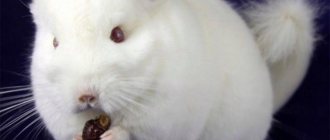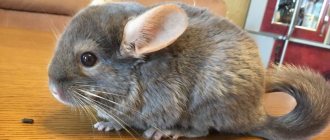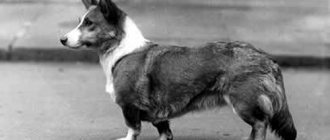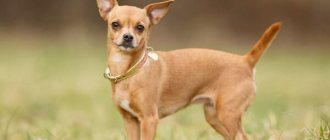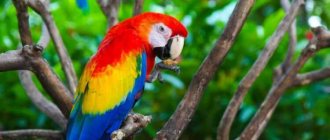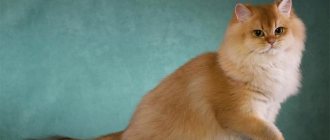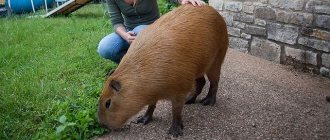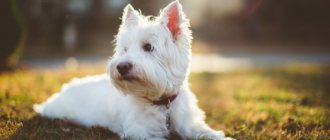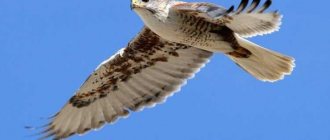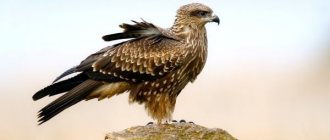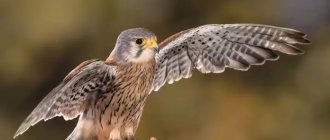- home
- Chinchilla
- Character and features
03/25/2019 There is a generally accepted opinion that the only chinchilla color is gray. However, this is not the case. For decades, breeders have been trying to develop fluffies with interesting colors. This article contains useful information about what colors of chinchillas can be found in nurseries.
Varieties of chinchillas
These animals come in two types, which differ in the size of the body and the size of the tail:
- Large short-tailed chinchillas (Peruvian) are native to Bolivia and some areas of the Argentine Andes. The fur of this chinchilla breed is so valuable that you will no longer see them in the wild. Today, such animals are raised only on farms. The short-tailed chinchilla has a strong body of 40 cm, weight 800 g. The tail is short with hard hair.
- Common, long-tailed (shore) chinchillas are still found in the Chilean Andes. They have a small body and an elongated tail covered with fur. Weight does not exceed 700 g.
Both chinchilla breeds are endowed with a gray color. Through selection of the Lesser Longtail, over 40 different colors of magnificent fur coats have appeared.
Angora chinchilla
The Royal Angora Chinchilla is a subspecies of the long-tailed chinchilla. Interestingly, it was not specifically bred. It was nature itself that gave us an animal with such a beautiful long coat.
The first rodents with this mutation were noticed in the 60s of the last century. However, the standard was described in 2001. Breeding the subspecies is extremely difficult. A pair of Angoras is likely to give birth to ordinary babies with short hair. Therefore, breeding such rodents requires high professionalism when selecting pairs.
Angora has a long silky coat, which is decorated with a luxurious tail. Another distinctive feature is the long fur on the head and paws. The muzzle is flattened, so these chinchillas have another “folk” name - Persian. The rarest individuals have the colors of black velvet, blue diamond, and violet.
Angora chinchilla is the most expensive. The cost of one copy can be several thousand dollars. The fur is so valuable that the high cost of the animal has been maintained for several decades.
Dwarf chinchillas
A natural genetic mutation caused the birth of mini chinchillas with a small body, short legs and a bushy tail. Weight does not exceed 300 g.
The dwarf chinchilla produces cubs of the same size as those of normal females. The miniature mother has a hard time giving birth. Often newborns do not survive. During pregnancy, the female is under the supervision of specialists. The colors of these cute fluffies can be varied.
Main differences between the species
In total, there are 2 types of chinchillas found in nature - short-tailed and long-tailed. They have absolutely the same habits and character. And they differ only in appearance:
- The long-tailed chinchilla is characterized by higher fertility. It is found in Chile, in the mountain ranges located on the Pacific coast. It is further divided into 2 subspecies – mountain and coastal. Mountain animals live exclusively on rocks, at an altitude of 3-5 thousand meters above sea level. Coastal ones do not rise above 2 thousand meters.
- The habitat of the short-tailed chinchilla is Chile, Argentina, Bolivia. They live only high in the mountains. Therefore, they have thicker, dense fur, which is why they are on the verge of extinction. They also differ from their long-tailed relatives in their stocky body, short neck and strong head. It is very rare to encounter a short-tailed chinchilla in its natural habitat.
All other species were bred artificially using breeding work with long-tailed chinchillas. The result is about 100 breeds, which differ mainly in color. And only 2 varieties have several more distinctive features:
- Angora chinchilla . It differs from all other species in its fluffy long fur and spreading tail. It also has a slightly flattened muzzle. The most expensive breed, since the necessary characteristics are not always inherited during breeding. And only experienced breeders are able to produce long-haired babies.
- Dwarf chinchilla . The main difference is the size. If ordinary chinchillas weigh 600-800 g, then dwarf chinchillas weigh 300-400 g. Otherwise, they are similar to the rest of their relatives.
It is worth noting that dwarfism is not the result of the work of breeders, but a natural mutation. Accordingly, the cubs of such chinchillas are born of normal sizes. As a result, dwarf females often die during childbirth. Therefore, these babies are absolutely not suitable for breeding.
Color options
In the wild, animals have many enemies. An inconspicuous and dim grayish fur coat is one of the shields. Rodents are less noticeable against the background of rocks.
Since people became interested in animals, white, black and beige breeds have been brought into the world. The result of many years of breeding research is rare colors. Today it is difficult to imagine that nature originally endowed this fluffy with only one color.
The entire palette of fur coats can be divided into the following groups:
- gray or agouti, which are considered standard;
- white with varying saturation or an admixture of pink, beige;
- brown or pastel, available in all colors, including chocolate;
- black with varying degrees of saturation;
- original fur coats in purple, sapphire and pink colors.
Animal colors are:
- Dominant, which are visible from birth.
- Recessive, when the rodent is only a carrier of the gene that is responsible for a certain fur color.
For breeding work, it is important to know what recessive color a rodent has.
Standard gray
Gray chinchillas exist in nature and in captivity.
There is a division by shade and depth:
- light;
- average;
- dark;
- moderately dark;
- extra dark.
This is the native color of wild chinchillas and their ancestors. Darker color on the back. The sides are light, the belly is snow-white. Color distribution on the hair: from gray-blue at the base to black at the crown.
What distinguishes individuals with gray colors is their health. They begin to bear offspring early. You can cross with any subspecies. The fur is pleasant and soft to the touch.
Light
A light gray fur coat with a silver tint looks very impressive. In such animals you can see a light shirt-front, abdomen, and paws.
Average
It is considered the typical and most common color. The body is a uniform gray color, lighter on the belly, chest and paws.
Dark
Gray fur with a blue tint and lighter coloring on the belly and chest makes rodents stand out from the general gray mass.
Moderately dark
Such animals have a dark gray coat that turns into spectacular ash on the paws, face and sides. Their belly is bluish-white.
Extra dark
Many fans have charcoal-gray chinchillas with light sides and chest. Their bellies are light beige.
Breeds with white fur
White chinchillas look elegant and representative. They have their own nuances.
White Wilson
Rodents, which are called white Wilson, are “dressed” in a white coat with possible admixtures of grayish or beige colors:
- Silver mosaic. The animal has a white fur coat with a silvery tint and dark fur on the head and base of the tail.
- Light mosaic. Rodents have light gray spots on a pure white coat. The scruff and ears are dark gray.
White chinchillas are not uncommon in nurseries. Breeders are willing to raise it, the color is in demand
Albino
Animals are not identified as a separate breed. An albino is an animal that lacks color pigment at the genetic level. Has milky fur and red eyes.
White Lova
A representative of an interesting variety of chinchillas is the White Lova. He has a white coat with a cream tint. Beautiful eyes the color of dark ruby.
White velvet
Rodents are carriers of a pleasant light velvet coat, which can be beige or silver. It is distinguished by expressive gray spots on the front legs and head.
White-pink
The milky coat of the rodent, which has black eyes and pinkish ears, produces a stunning effect. An individual with a pink back looks even more interesting.
Gray standard (Standart)
The gray chinchilla is one of the most common species. This is explained by the fact that this color is natural. The Incas began breeding rodents of exactly this color many centuries ago. They called them "chincha", which means "bug". All other colors were developed artificially much later.
Their belly is white, and the rest of the fur is grayish, with a smooth transition from light to darker. There are:
- Light.
- Average.
- Dark standard.
The gene responsible for this coloration is called agoti. It is thanks to him that the smooth play of fur is created. It ensures the presence of pigment granules in certain areas, so each hair has a black or bluish lower part, a snow-white middle part, and a black tip.
Gray individuals are larger and stronger than others and reach maturity early. This color is a simple dominant one; crossing gray individuals with any others is allowed.
Animals with beige color
Beige chinchilla (pastel) may have variations in shades. The older the animal, the darker its coat will be. It can be red, beige, brown. Animals are allowed to crossbreed.
Beige homozygous
Homobeige rodents with uniformly colored light beige fur have pink ears. The fur has no shading zoning; single hairs with dark “tops” are acceptable.
Heterobeige
Heterobeige, on the contrary, has uneven color. The entire fur is beige, and the undercoat and ends of the hairs are dark brown.
A heterobeige chinchilla with yellowness indicates a deterioration in breed qualities.
When choosing an animal, you must definitely consider the color line between the belly and the rest of the body.
Beige Tower
An animal with a coat color ranging from light to dark beige in combination with a brown ornament on the back looks intriguing.
Wellman's beige
A gentle little animal with light beige fur, delicate light ears and, as a contrast, black beady eyes.
Sullivan's Beige
The rodents that bear such a beautiful name have a rich beige coat and red eyes.
Brown velvet
These types of chinchillas have beige fur as a base, and their back and head are chocolate. The abdomen is sand-colored, sometimes almost white.
Ebony breed
The main difference between this chinchilla breed is not the color, but the quality of the fur. It shines extraordinarily and shimmers in the light. The color palette can be varied.
Homoebony
Black ebony is a rare type of color. The animals have a coal-black coat and black eyes. The second name for animals is charcoal.
Heteroebony
The shiny dark coat of heteroebony rodents combines two palettes: black and gray. Both options are great and eye-catching at exhibitions.
White ebony
There are chinchillas with a shining snow-white coat, which is given a special charm by black coating at the ends of the hairs. The paws, head and beginning of the tail can be gray or beige.
Animal skeleton
The body structure of chinchillas provides them with reliable shelter and makes it possible to survive in rocky mountain conditions. The chinchilla's skeleton tapers when necessary. The need may arise when an animal hides in narrow crevices from predators and bad weather. There are 5 toes on the front legs of rodents, and 4 on the hind legs. The hind legs are longer and stronger than the front ones, which allows the animals to jump high.
Rodents have a set of 20 strong teeth that grow throughout their lives. Newborn babies have developed dental systems: there are 12 teeth at once.
How to determine the age of a chinchilla?
By external signs it is easy to determine the age of the animal. Determination is possible in several ways:
- By weight: at two months of age - up to 300 grams, at six months - up to 500 grams, per year - up to 800 grams.
- On the heels: young individuals have delicate skin on the heels. To determine age more accurately, the paws of an individual whose age is unknown can be compared with those for whom this indicator is known.
- According to the muzzle: with age, the muzzle becomes longer.
- In size: at 3-4 months a chinchilla is close to the size of a guinea pig, at 6 months and after the animal can be compared to a rabbit.
- By the color of the teeth: up to 2 months, the teeth are white, and when chinchillas grow up, the color of their teeth becomes orange.
- By sexual characteristics: in males, testicles appear by the fifth month of life; by the age of seven months, the genital organs are already easy to distinguish from female ones.
- According to the ear flaps: chinchillas with the beige gene begin to have flaps on their ears by the age of 5 months. There should be more than 2 of them per year, and in an adult at the age of 3-4 years, all the ears are covered with spots.
Breeds of chinchillas with dark fur coats
Among the homoebony with rich black fur, the “black velvet” breed is distinguished.
Black velvet
The contrast of black and white is always mesmerizing. Fluffies with black fur on the body and tail combined with a light belly look amazing. The clearer the border of contrasts, the more valued the breed is.
The variety was bred in the 60s of the last century. It is believed that dark fur indicates the high quality of the breed. Black Velvet is distinguished by its markings: light stripes on its paws, charcoal mask, darkened fur on its head. The older the animal, the more clearly the breed characteristics are expressed. Breeders warn: the gene is lethal. Crossing “velvet” animals is prohibited. This will end badly for the mother and cubs.
Floor
Everything is simple here. Females are valued and almost everyone is eager to adopt them if they are a professional breeder. Oddly enough, there are usually more boys born, so there is no shortage of them.
Males are not yet so valued because chinchillas are polygamous animals. You can keep just 1 male for several females and you will not have any problems with reproduction.
If you plan to buy only 1 animal for your home, then it is better to take a male, since its maintenance is no different from a female, and it costs at least 1.5 times less.
Rare breeds
The most expensive chinchillas have a rare and amazing color. Breeders have developed interesting breeds of animals that cause genuine delight.
Violet
The fabulous light lilac fur of the body contrasts with the white belly. There is a purple impurity on the nose and ears.
The lavender color is passed on through the first and second generations. Rodents become sexually mature late. The ability to produce offspring occurs by one and a half years.
Sapphire
Bluish-gray or light blue fur with a graphite veil in combination with a white belly and pink ears looks simply amazing. The eyes are shiny black. Sapphires are one of the most expensive and sought after chinchillas.
Color appears by 7–8 months. It is better to purchase younger rodents with a declared sapphire color in specialized nurseries.
Blue Diamond
Pedigree chinchillas with light blue fur, a metallic tint and a dark pattern on the ridge and head are more valuable than sapphire ones.
White and pink diamond
Animals with a pearl coat and a shade of rose are considered rare. Ears are harmonious pink.
Animals have a lethal gene, so they cannot be paired together. They will make an excellent pair with rodents of other coat colors.
Interesting Facts
- These rodents have a well-developed cerebellum, which helps coordinate the movements of the animals. Therefore, they deftly cope with climbing rocks and other obstacles even at night.
- The chinchilla's whiskers - vibrissae - are also well developed. With their help, the animal gropes for food in the dark and hard-to-reach places.
- Chinchilla ears can detect an enemy at a fairly large distance.
- The animal's fur is unique - it is able to maintain the desired body temperature when the weather changes.
- Animals can reject fur if a predator grabs it. The new cover grows in a couple of months. The thick undercoat prevents parasites from settling on the animal’s body.
- Male chinchillas are easier to tame. The female can be offended if she is not the one picked up first.
- These animals are very clean. The animal does not make a toilet near the feeder and water bowl, and its feces do not emit an unpleasant odor.
- There is also no unpleasant odor from the animals themselves, since they do not have sweat glands on their bodies.
- Chinchillas are easy to train. Simple commands “sit” and “stand” can be mastered by any animal.
- They are nocturnal animals, so they sleep most of the day. No matter how much a chinchilla sleeps during the day, you cannot wake it up!
Source
Crossing chinchillas
The variety of colors is a boon for skilled breeders. The process of crossing is very exciting, since there is always the possibility of the manifestation of a recessive gene of one of the parents in the offspring.
There is a serious limitation when making a pair. You cannot combine two lethal genes: white and black. This will lead to the death of newborns. The female may also die during the period of bearing babies.
To successfully crossbreed rodents, breeders are issued animal passports. The document officially states which genes the pet is a carrier of. The possible color of the cubs is calculated using a color calculator.
Where do they live?
The historical homeland of the chinchilla is South America. Colonies of animals lived almost along the entire western coast. During the period of active trapping of fur-bearing animals, hunters burned vegetation to get to their burrows and shelters. A significant decrease in the number of animals, as well as the destruction of some plant species, reduced the habitat of the genus.
Currently, chinchillas are found only in central Chile, where the Chinchilla National Reserve was created in 1983 to preserve them.
Where do chinchillas live?
The usual habitat is mountainous terrain with little vegetation. Animals make shelters for themselves between stones, in crevices, caves; if necessary, they can dig a hole or make a home in the abandoned holes of other animals.
Natural enemies
In their natural habitat, rodents become food for foxes, snakes, and large birds of prey. Protection from enemies is the camouflage coloring of the fur, good reaction and coordination, and speed of movement. Hiding from persecution, chinchillas hide in crevices and voids. The structural features of the skeleton enable the animal to penetrate narrow openings and crevices. Another unique feature of the chinchilla is that it can literally shoot out tufts of fur, discarding it in the place where the predator has grabbed hold.
A LION
